Dredd
“I am The Law.”

In a crime-ridden dystopian future, Mega City One is a vast, violent metropolis. Standing against the chaos are the Judges, law enforcement officers who patrol the streets as judge, jury, and executioner, and amongst their fearsome assemblage, the one known as Judge Dredd is the most fearsome of all.
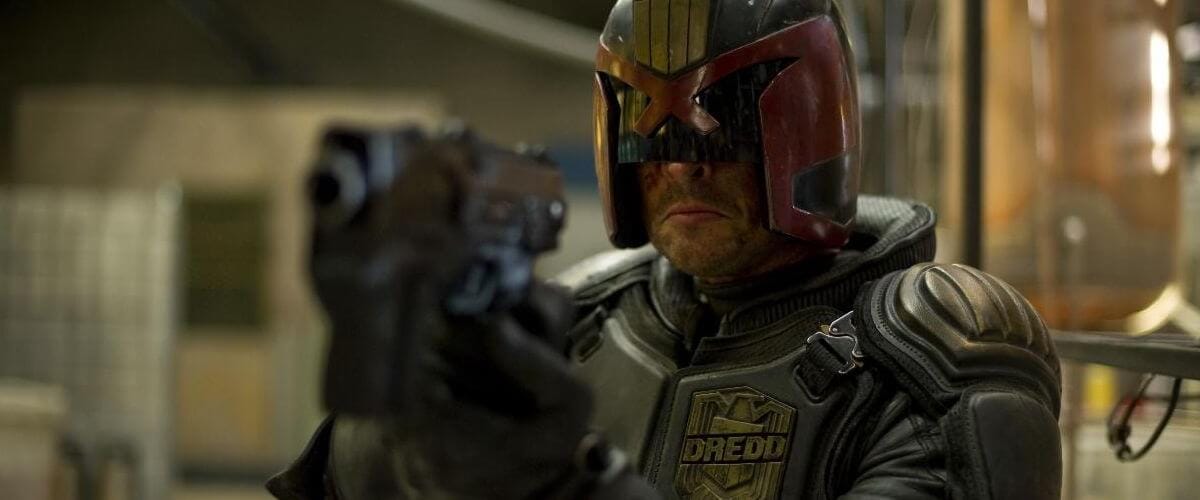
Judge Joseph Dredd is a comic book character that was created by writer John Wagner and artist Carlos in 1977. First appearing in the second issue of the British weekly anthology comic 2000 AD, for years, he was the magazine's longest-running character, until he got his own title, Judge Dredd Megazine (yes, MEGA-zine), in 1990.
Cribbing his name from the stage name of the British ska and reggae artist, Alexander Minto Hughes, who was one of the most banned recording artists from television and radio by the BBC, apparently due to his near-constant use of sexual innuendos and double entendre—which, just looking at a picture of the guy? Yep, I can see it—and then additionally inspired by the David Carradine character Frankenstein from the movie Deathrace 2000, Judge Dredd is what is known as a “street judge.“ As such, he is empowered to summarily arrest, convict, sentence, and execute criminals, while working in the dystopian urban nightmare future city of Mega-City One, a sprawling megacity that covers the majority of the east coast of North America.
Dressed in massive epaulets, one in the shape of an eagle with wings spread, a Judge’s helmet obscures his face, except for his mouth and jaw. And when it comes to Dredd specifically, the helmet is basically never removed. If he ever does take it off, his face is obscured. This is a basic guiding tenet of the character, Judge Dredd is faceless, as he is meant to represent the facelessness of justice. This way, he is as much a man as he is an ideal, less a true 3-dimensional character, and much more of an avatar of the cold edifice of justice, with all the attendant, and often graphic, violence that is his main tool. This all becomes apparent the moment you see the extreme and often oddly-proportioned ways in which the character and his world have often been depicted over the years.
He looks like Structural Violence personified.
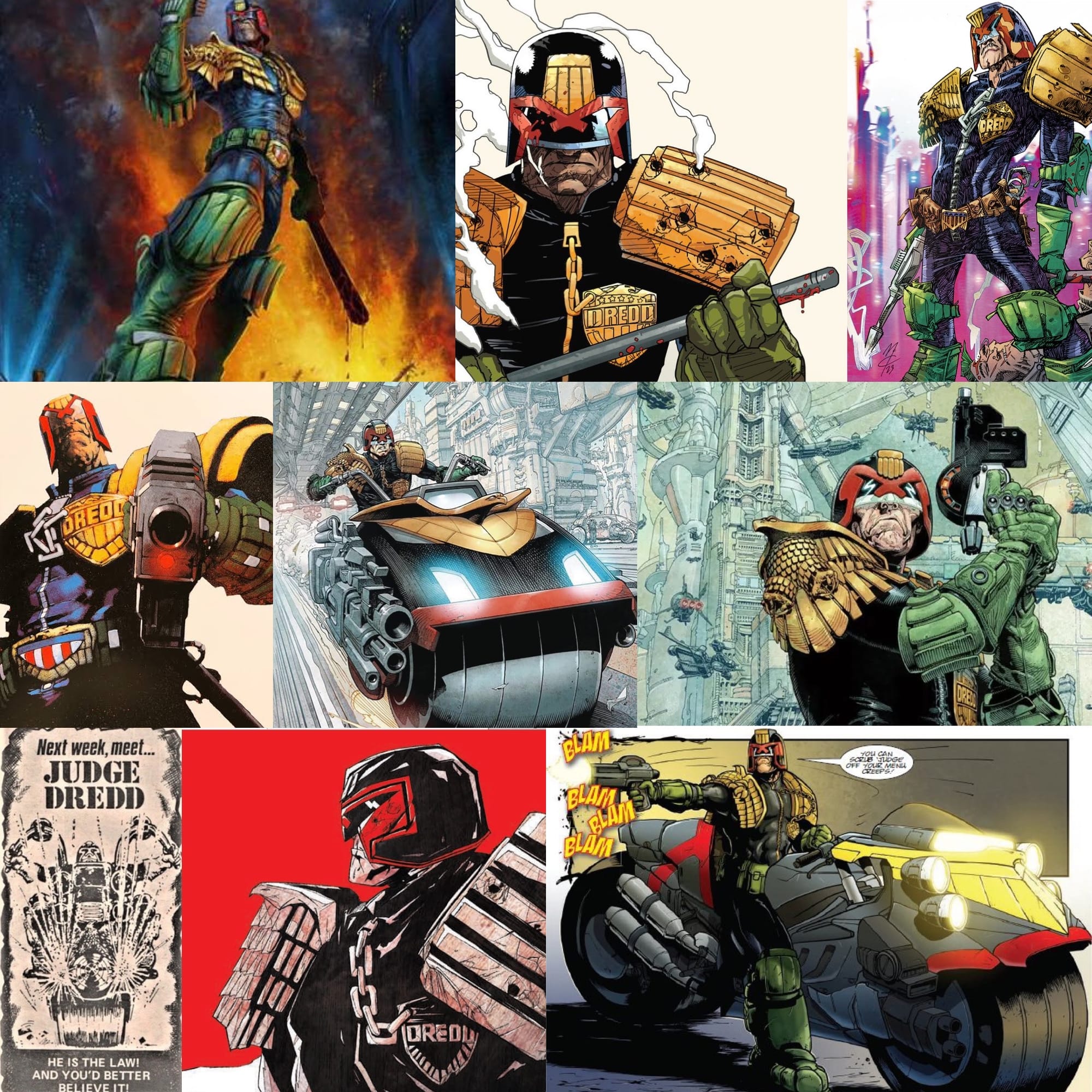
His catchphrase is a simple one: “I am the Law.”
Judge Dredd is armed with a "Lawgiver" pistol. This is the primary sidearm of the Judges. It has aim-assisted firing, and is capable of firing six types of ammunition, which can be switched between by the Judge’s voice command. The various types includes standard ammunition, which can be fired on semi and automatic. There’s heat-seeking rounds, white phosphorus incendiary rounds, armor-piercing rounds, explosive rounds, and even a rubber-coated round that can ricochet bullets around corners, or off walls, should a perp attempt to hide behind a human shield. It also has a palm-print failsafe so that it will only fire for the specific Judge it is assigned to, and should someone else attempt to use the weapon, it explodes.
The classic design of the Lawgiver is a really odd one, bulky and long and oddly contoured, it is reminiscent of old pulp era ray-guns. It also is clearly coming from a British pistol design point of view, and decidedly not an American one. To me, it mostly seems like it would be difficult to fit comfortably in a holster.
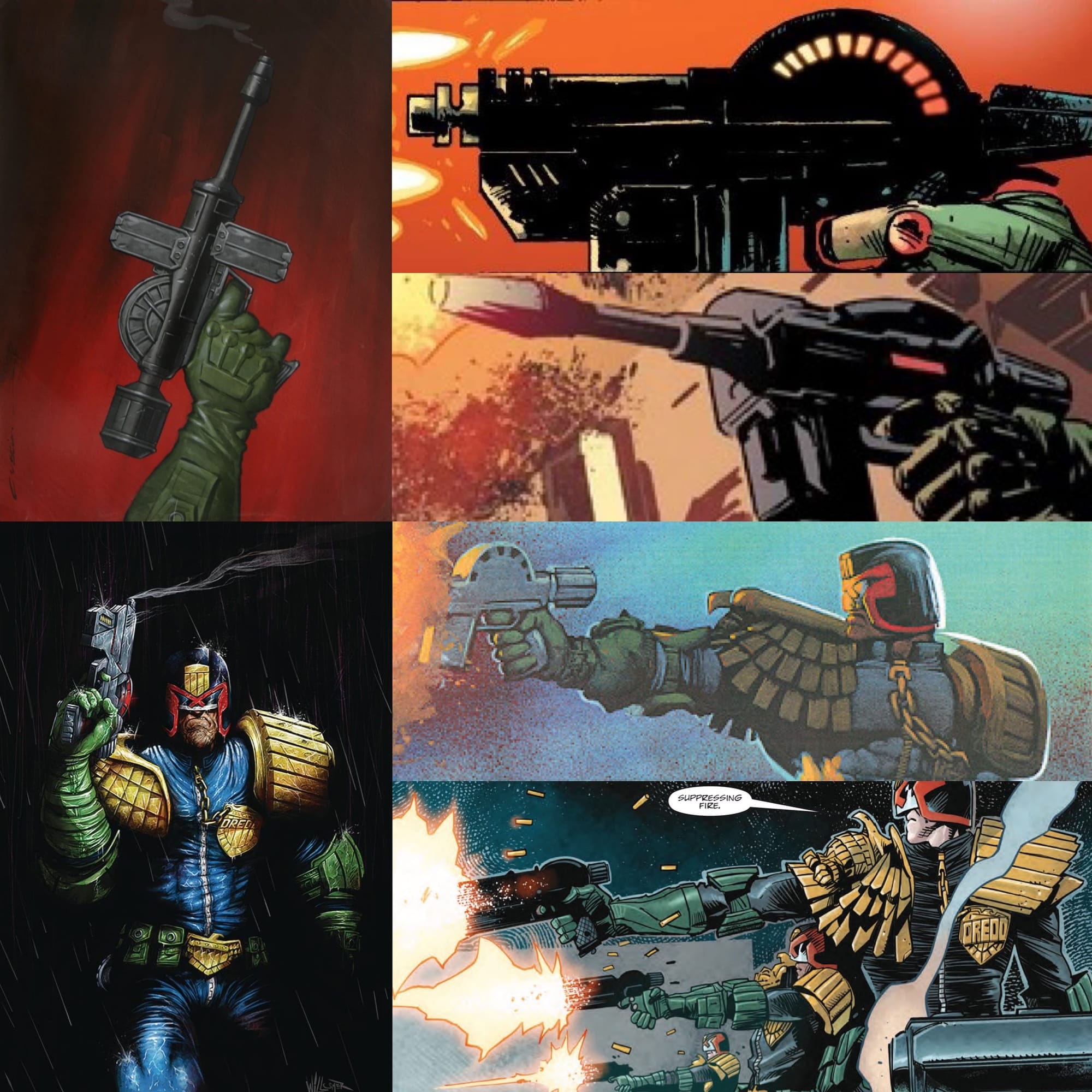
Judges patrol the streets of the Mega Cities on a large "Lawmaster" motorcycle. It is equipped with multiple weapons, as well as an A.I. that is capable of responding to orders from the Judge, and also of operating itself, if need be. Reliably, over the years, the Lawmaster has been depicted to look a lot like a big throbbing penis, a massive, aggressive, rude vehicle, usually roaring down the street.
There’s literally no aspect of this character that could be said to be subtle.
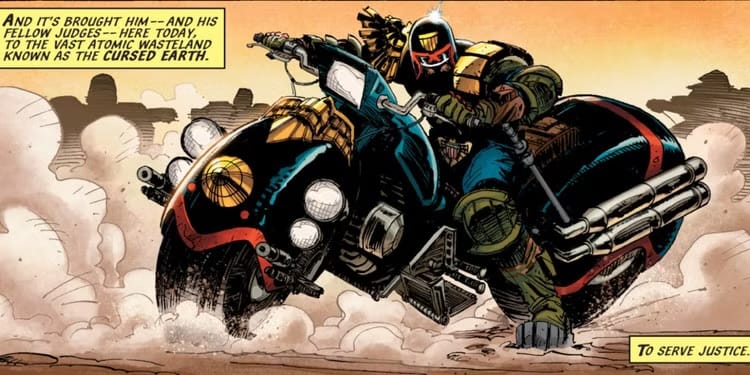
I’ve never really been a big fan.
Y’see, the main thing about Judge Dredd stories, is that they are often used as a vehicle to satirize American and British culture, with a specific focus on fascism, authoritarianism, and police brutality. And while, I’m not sitting here saying that this isn’t true, it obviously is. The outfit alone screams fascism. The very premise of the series is centered on authoritarianism and the kind of irrational, racism-rooted fears of “urban” areas that are responsible for White Flight, America’s segregated suburbs, and also Redlining and the American highway system through American cities, the whole thing is rooted in the kind of racism-rooted fears that you can still find to this day dominating the Facebook pages of mediocre bigot fucks in predominantly white suburbs and small towns all across this nation, as they regale each other with stories of burnt-down, crime-ridden cities under the sway of ”the elites” and “the globalists” that are bowing before the hysterical socialist demands of purple-haired liberals and Sharia Law, the very same cities that these weirdo fucking freaks then go to multiple times a year for all their basic bitch vacations, their shit country music concerts, their sporting events, and their shopping trips and fancy dinners. So, yes, at it’s very core, Judge Dredd is undeniably a parody of the roots of that racist bullshit, as it embraces the Dirty Harry trope and pushes it to ridiculous extremes. But if we’re being honest here, and we would like to be, if you don’t mind, on the whole, those extreme depictions are clearly more of the point than the “parody” ever is.
And even when the satire is there, when it’s actually part of the story, and it’s not just apparent in the obvious roots of the extreme design choices of the stories and the settings, it’s usually the thinnest, most 2nd-thought “satire” one could find. It’s there, okay, sure, I’ll allow that, but is it really? Is it really the main point? Does it ever ride to the same level of even something obvious like, say… Starship Troopers or Robocop? Judge Dredd wishes it could stand next to Paul Verhoeven. I‘ve never even seen it come close. It’s been my experience that whenever anyone is making a big a deal out of the “satire” of Judge Dredd, its mostly just to justify their own enjoyment of the violence, so they make a mountain of the molehill.
I blame a lot of this on American comic book nerds.
Your mileage may vary, of course, but I’m an old comic nerd from America. As evidence of this, I’ll say that my X-Men subscription, way back in the day, well past The Fall of the Mutants, maybe even to as late as the Inferno storyline, would arrive in the mailbox in these butcher’s paper-like brown paper sleeves that were open on each end. And it was a couple of years before they finally switched over to sealed plastic bags and boards. So, until then, if it rained, my comic would get wet. That’s how Marvel sent it to me. That’s how long I’ve been around. I’ve been around so long, in fact, that I put this question to you, my friends…
Does Marvel Comics even have a home subscription service anymore?
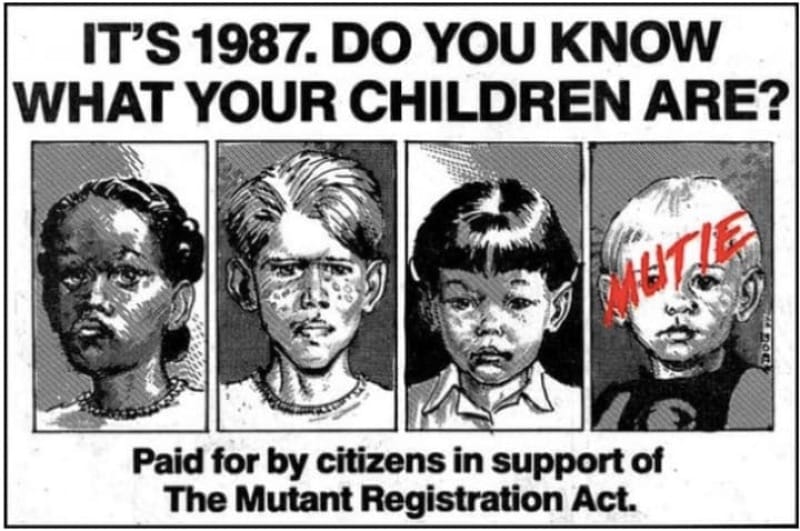
My point is, however culturally relevant it may have been in the UK, in America, Judge Dredd is comic book that, for a long time, was just one of those things, one of the holy artifacts of Comic Book Nerd Hipsterism. It occupied a space for Comic Book Nerds that was similar to the one that films like La Jetee, Eraserhead, or Testsuo: The Iron Man did for Filmhead Hipsters.
This meant it was something that was very difficult to get ahold of in America, especially if you lived outside of the larger cities, and even a couple of decades ago, if you lived in a larger town or a more rural area, somewhere that wasn’t able to support even a half-decent comic book shop, you still couldn’t get it easily, even though comic book culture had gotten more of foothold in mainstream culture. As a result, Judge Dredd was one of those titles that had a fair amount of cachet, quite a bit of intracultural value, it was legendary, if you will. As a result, it was beloved of the comic book snob set, because if you had read it, you could wear that shit like a badge of honor, as an indication of your enviable bonafides. You knew more. You had seen more. You were In The Know. Now, you could hold forth to an audience of lesser nerds. You could say shit like: “Oh, I don’t read cape comics, I read indie comics like Bone, or Love and Rockets, or foreign comics like Judge Dredd. They’re doing so much more interesting work, y’know…”
Absolutely insufferable.
Not that those books aren’t good, but still.
Anyway, because we were all dumb full-of-shit pop culture nerds forever locked in a steely-eyed game of brinkmanship, a never-ending war of one-upmanship waged over grease-smudged glass counter cases filled with Magic: the Gathering Cards, and between the leaning stacks of musty old comic books no one will ever want, even in the 5 for $1 bin, tucked way back in the far corner of some dim comic shop where the "cool" nerds hung out, the legend of titles like Judge Dredd grew and grew. “Oh yes, it‘s true, Judge Dredd is indeed much more violent than American comics (said with great disdain), more violent than you could probably handle, honestly, but people who are familiar with Judge Dredd already know, it’s not about the violence, you philistine, it’s a satire, it’s got layers, it has something to say. It’s a parody of America, and the violence inherent to our society. It’s a commentary on police brutality, kid. Go get the new issue of Gen13. You're not ready for Judge Dredd. You wouldn't understand.”
And since this was based on something that always at least nominally true, it allowed comic book snobs a way to both poo-poo the grim and gritty bullshit of plebeian mainstream comics coming from publishers like Marvel or DC or Image, while also allowing them to indulge in their love of those same tropes, often in a much more graphic story too. It was basically a way for a bunch nerds to be low level hypocrites, while lording their nerd cake over other nerds, and eating it too.
And why not? After all, nothin like a bit of the ol’ ultra-violence, as they say…
But for me, the book never really clicked. When it came to British comics, or at least, the British Invasion comics, I was much more of an Invisibles kind of fan. I just wasn’t into Judge Dredd personally, or the kind of art it featured, or the general style, and often found the stories kind of dull. Now, this wasn’t always true, I mean, it is true to say that, much like The Punisher, or the grim and gritty era of Batman, Judge Dredd as a character type just isn’t up my alley. I’m not saying that it was all awful. It just… was what it was, and that generally wasn’t for me. And to be fair, a comic book is always either good or terrible, depending on the particular creative team. But I was also playing the Game of Nerds too, and there is nothing that cuts a wannabe Nerd Hipsters more deeply than a casual off-handed dismissal of their holy bonafides as being dull and uninteresting. Ha! In your face, nerd. Check and Mate. We are now enemies forever.
That last part is actually true.
There are probably several nerds out there that I burned in some random nerd debate at some point, gentleman who, to this day, if we randomly saw each other in public, it’d be a lot like… well, this… but y’know, slower and fatter.
So, anyway, I’m fine with Judge Dredd. I’ve dipped in and out over the years. Also, I did enjoy the cheesey ridiculousness of the Sylvester Stallone 1995 film version of Judge Dredd. Although notably, Stallone didn’t have the guts as an actor to wear the helmet the entire time, even though that's what Judge Dredd is supposed to do, so it’s a subpar version.
Dredd (2012), meanwhile, is not subpar.
I loved Dredd.
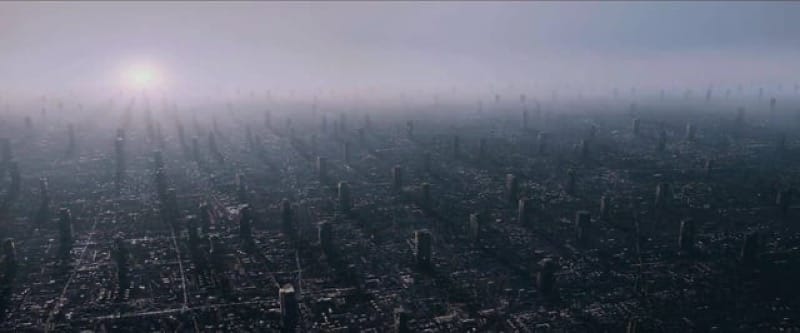
“America is an irradiated wasteland. Within it lies a city. Outside the boundary walls, a desert, a cursed Earth. Inside the walls, a cursed city stretching from Boston to Washington D.C., an unbroken concrete landscape. 800 million people living in the ruin of the old world and the mega-structures of the new one. Mega blocks. Mega highways. Mega City One. Convulsing. Choking. Breaking under its own weight. Citizens living in fear of the streets. The gun. The gang. Only one thing fighting for order in the chaos: the men and women of the Hall of Justice. Juries. Executioners. Judges…”
And so the film begins…
Mega City One is a nightmare version of America’s cities. The Judges are a nightmare version of American police. Judge Dredd in particular is a no-nonsense nightmare version of American justice, and a cold mother fucker.
Mega City One is home to 800 million souls. It is a place where, due to the irradiated world beyond the city’s walls, and the incredibly close confines within them, burying your dead is a privilege reserved for the super-rich. The common dead are sent to the nearest Resyk Center, where the body is broken down to its basic components, to be used for manufacturing, organ donation, or food. When one of the Judges says that Mega City One is a “meat grinder," they are being both literal and figurative.
On this day, the Chief Judge assigns veteran officer Judge Dredd with assessing a brand new rookie Judge named Cassandra Anderson.

Cassandra Anderson is a very green rookie Judge. She is also a mutant due to exposure to radiation, but of the more classic X-Men style of glittering glitterati mutants in a world where most mutants are horribly disfigured, so she is cute little blonde psychic with a cute little blonde bob, and she can’t wear her helmet because it interferes with her psychic abilities, so we get to see her cute little face. Anderson failed her Judge's aptitude tests by a few points, but the Justice Department wants mutants like her, with powers like hers, to become a part of the new generation of street judges, who will bring a lasting order from the chaos, because otherwise, as things stand now, they are losing the war for control of Mega City One.
Dredd believes that Anderson failing her assessment tests means that she is a failure, and shouldn’t be a Judge, but it’s an order from the Department of Justice, and above all else, Dredd follows orders… and the law. So even though all her tests indicate that she isn’t cut out for the job, Dredd will give her a fair assessment, and determine whether or not she is capable of surviving in a city where twelve serious crimes are reported a minute, around 17000 a day, the Judges can only respond to 6%, and one in five rookie Judges don’t survive their first shift. As they set out, he informs her that disobedience, incorrect sentencing, or being disarmed, or losing her weapon, will result in an automatic fail.
Anderson, on the other hand, is a bright-eyed young idealist who truly believes that she can make a difference and affect a positive change in the city.
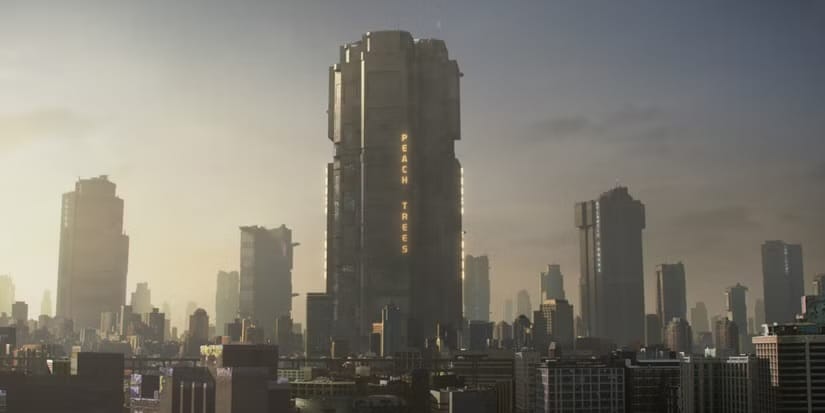
The Mega-blocks are impossibly high structures, two hundred levels high, and rising about Mega City One. With a central open space from the massive courtyard commons at the bottom, and up all the way to the top, the Mega-blocks are vertical cities onto themselves, a place you could live and die in without ever having left it. Officially classified as a “slum,” the Peach Trees Mega-block in Sector 13 of Mega City One houses over 75000 citizens. It also has an unemployment rate of 96%, and as a result, the highest crime rate in its sector.
Madeline Madrigal lives there. She is known as Ma-ma.
A former sex worker turned brutal crime boss, over the years, Ma-ma has wrested control of the entire Peach Tree Mega-block from the other gangs there, the Peyote Kings, the Red Dragons, the Judged, she wiped them all out, and turned the tower into the central processing plant, and the main distribution hub, for the hot new drug taking the city by storm known as Slo-mo. A carmel-colored liquid taken via an inhaler, Slo-mo gives the user a euphoric feeling, while slowing their perception of time to 1% its normal speed, as the whole world brightens and becomes more vivid. Ma-ma rules her empire with an iron fist.
Don’t fuck with the Ma-ma Clan.
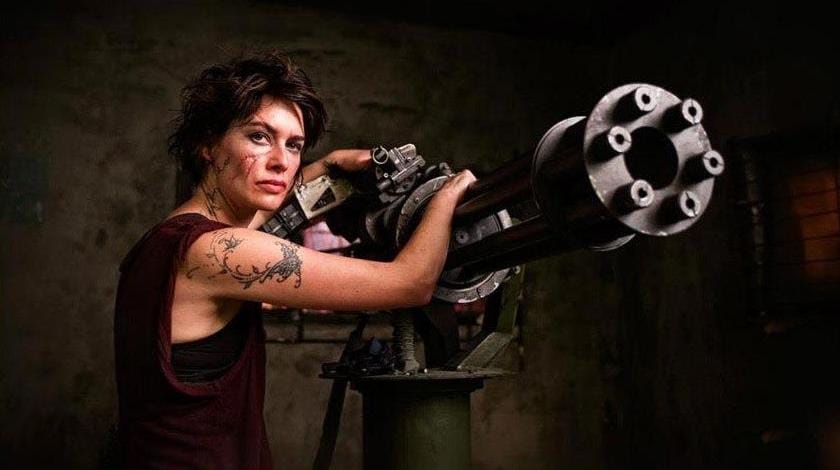
So when Ma-ma very publicly, very brutally disposes of three men who betrayed her—throwing their skinned bodies from the 200th floor to the open courtyard far below—rookie Judge Cassandra Anderson, upon being urged by Judge Dredd to chose the first call they respond to during her assessment, she chooses this. A triple homicide at the Peach Trees Mega-block.
And thus, Ma-ma’s business lands on Judge Dredd’s docket.
But Ma-ma believes herself to be above the Law, and that Peach Trees belongs to her, so when Dredd and Anderson gets too close to uncovering her little world, she locks down the entire Mega-block, sealing it off from the outside world with doors meant to withstand a nuclear bombing, trapping everyone inside, including Dredd and Anderson. She then turns her entire gang, 200 levels of fanatically devoted and well-armed thugs, loose to hunt down the two Judges.
But is Dredd trapped inside Peach Trees with Ma-ma and her thugs… or is Ma-ma and her thugs trapped inside Peach Trees with Dredd?
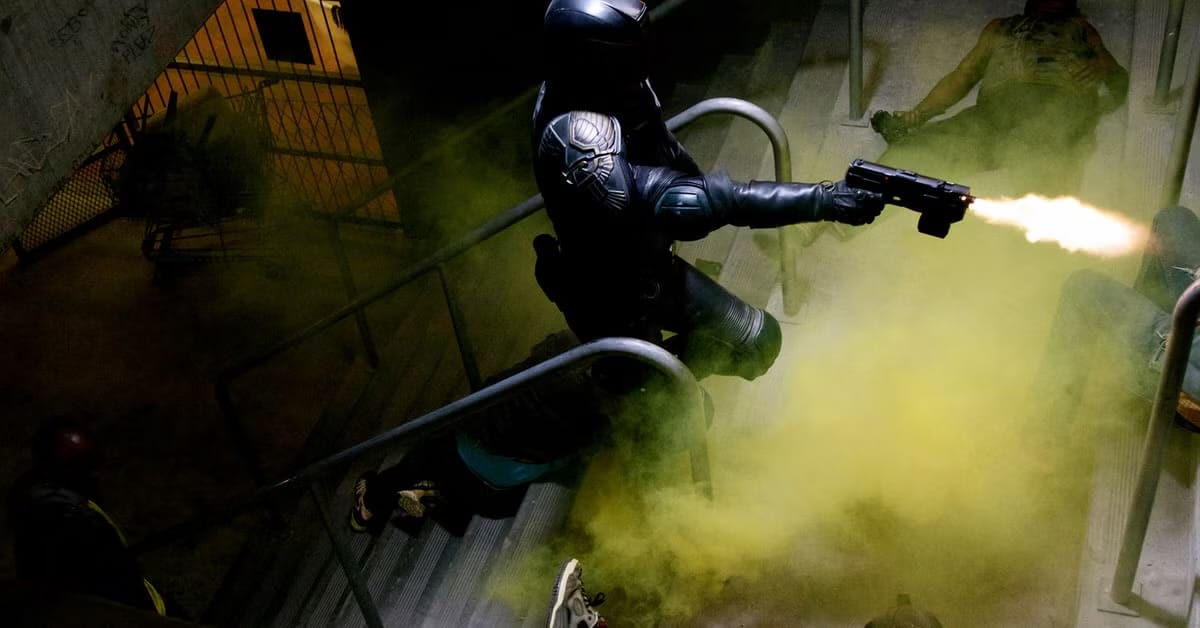
Written by Alex Garland, a screenwriter who always either impresses or infuriates me—who also may have actually directed and edited the film, rather than the reportedly sidelined, but credited director Pete Travis—and very clearly filmed in Johannesburg, Dredd is about all the things that Judge Dredd has always been about… Militarized police, the surveillance state, automatic sentencing, police corruption, weaponized poverty, graphic violence, and a character and a storyline, that according to Judge Dredd creator John Wagner, is “pure Dredd.”
Originally released on September 7th, 2012 in the United Kingdom and on September 21st worldwide. The film’s critical reception was generally positive, especially about the film's visual effects, cast, and action sequences. Unfortunately, despite that generally positive critical response, the film only (“only”) earned $41 million at the box office against a budget somewhere between $30–45 million, so that’s a pretty clear failure, making a sequel unlikely. But then, since this film was originally released in 2012, that should probably be pretty obvious at this point.
Most of the criticism for Dredd focused on the graphic violence, of course, as well as a perceived lack of satirical elements that some claim are usually found in the comic, but again, this is a part of the perception of the series that should be taken with a grain of salt and a heavy rolling of the eye.
Otherwise, the most common complaint was from the loudmouth halfwits who think they’re smart, so they rush to prove that to the world, but really only end up showing everyone that they have no idea at all what they’re talking about. These dummies loved to loudly trumpet that Dredd was clearly ripping off the film The Raid, an incredibly super-cool Indonesian action film, which also has a sequel, The Raid 2, which is even cooler. Anyway, both The Raid and Dredd are about cops locked in a high-rise, with gangs of thugs trying to kill them. Because of this, these dipshits all started to scream plagiarism, despite the fact that The Raid was released on March 23rd, 2012, and Dredd was released that September, meaning that both films were clearly filmed at about the same time, and on opposite sides of the globe to boot, and thus, neither film could have copied the other in any way.
Fandom is the worst.
Anyway, I really like the whole look of this movie. It definitely has more of a ”Day After Tomorrow” future feel, which is a lot different from the source comic's wild dystopian far-future setting. But the film clearly didn’t have the budget for any of that kind of outlandishness, so I really appreciate the filmmakers recognizing this, and making the adjustment in order to make the best film that they can. As always with these kinds of things, your mileage will vary, and also, keep in mind that I’m not the world’s biggest Judge Dredd fan, but the end result here is pretty perfectly done, I think.
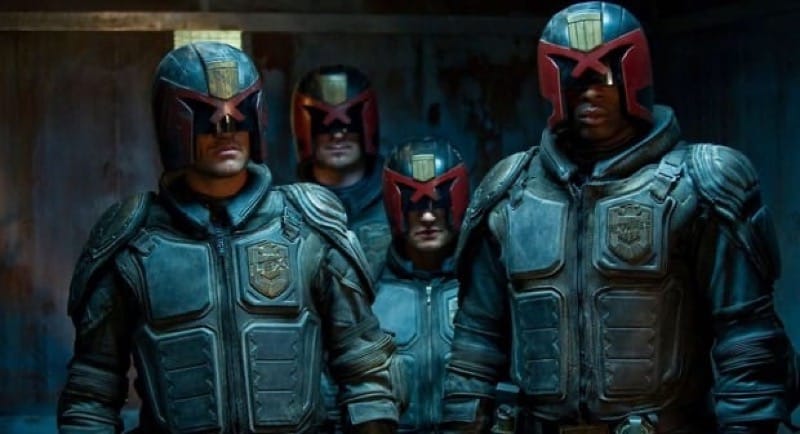
Similarly, I really love the costume adaption for this film. It clearly leans more towards the idea of “realism,“ and your mileage may also vary on that, but again, it fits the budget, and it fits with the general feel and tone of the rest of the film, so that’s a good job. Plus, just on it’s own… I think the Judge costumes look cool.
Much like the Murderbot costume, if they ever make a really good six inch action figure of this movie’s version of Judge Dredd, I will buy it.

That said, I do think they failed a bit on the adaptation of the Lawmaster design. They missed the rude turbo-charged phallic nature of thing. I understand that the more accurate version that was used in the 1995 film was basically impossible to steer due to the ridiculously fat tires, but still… this version didn’t impress in the way that the rest of the film did.
That this film otherwise generally makes a lot of good decisions when it comes to killing off a lot of the loved, but unnecessary, darlings from the source material, and just gives us the good red meat, makes this aspect pretty disappointing.
That said, it’s not a deal breaker.
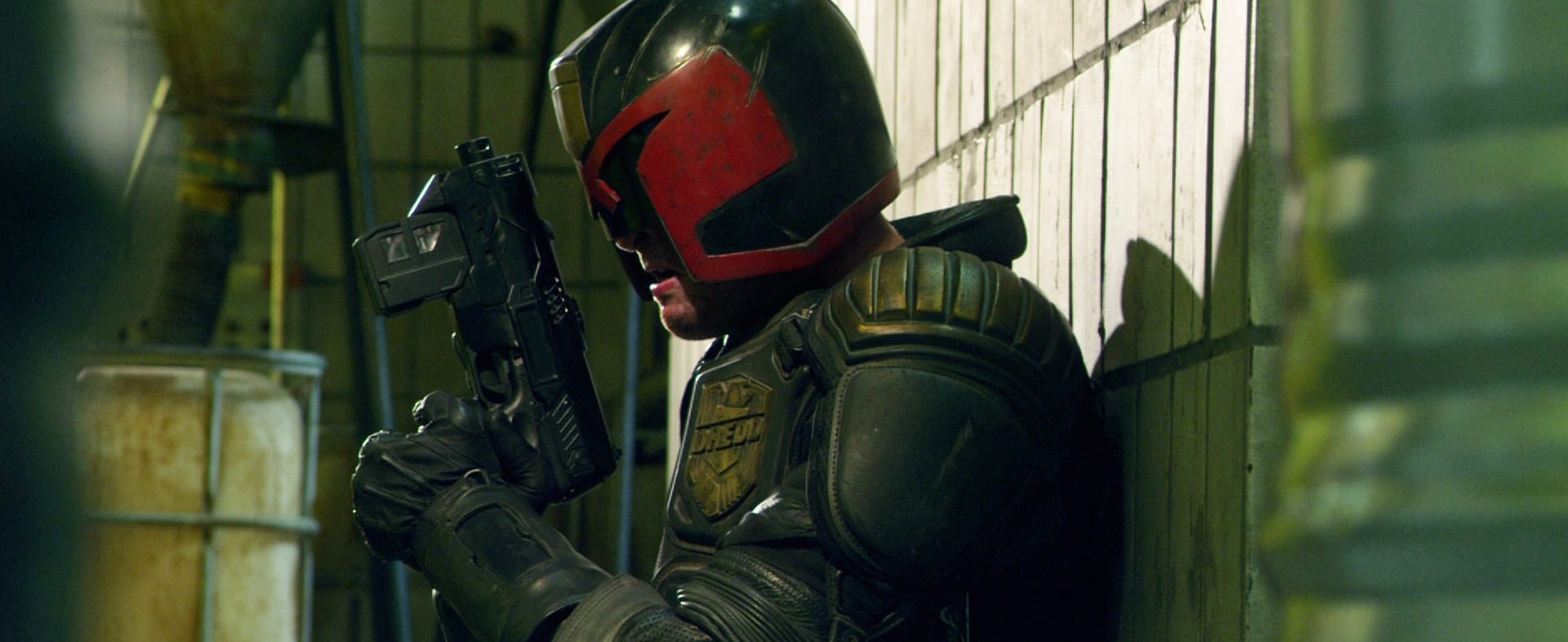
The cast is all pretty good too. It’s great to see Wood Harris outside of The Wire. And Domhnall Gleeson was a welcome addition as Ma-ma’s tech guy. I wouldn’t expect Lena Headey or Olivia Thirlby to be cast in this kind of film, and I have no idea how that happened, but I’m glad they were, because they were really good as Ma-man and Anderson respectively. Karl Urban, of course, nails the role of Dredd in a surprisingly effective way, using his stubbled and scowling chin beneath the visor of his helmet as a surprisingly emotive tool.
And while it probably sounds silly to say this, at one point, Urban’s line reading of the single word: “interesting” is particularly good. The way he says that one word, a sneered growl, all while barely moving his body, and his lower face in a scowl, he reveals layers of intent, giving us honest surprise, an impressed reassessment, and even a kind of relief at the sudden clarity, not to mention obvious excitement at the promise of him now being able to deliver righteous judgement. It’s really good work. I’m probably over-selling it, but still… good stuff.
And yeah, the effects are great. The violence and blood and gunfire are really well done. But it’s the effects of the Slo-mo drug in particular that are the most cool, as the world gets brighter and slower, and it’s used to pretty cool effect in the film.
Dredd is a straight up good time, a balls to the wall, bad ass sci-fi action film, the kind they don’t make anymore. It is hands down the best and most beautiful child of the wild and often terrible coterie of lesser known sci-fi action movies of the 90s that once littered the aisles of the video stores of old, like Strange Days, Nemesis, Hardware, Fortress, Freejack, Prototype, No Escape, and… Judge Dredd.
Big thumbs up.
